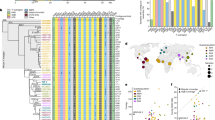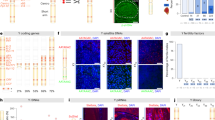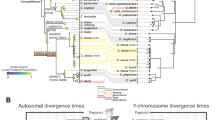Abstract
HUMAN–mouse cell hybrids usually exhibit preferential loss of human chromosomes1,2. After a time interval, which depends in part on the cell types used, most or sometimes all the human chromosomes segregate out from the hybrid cells3. In the course of investigation of the phenomenon of preferential loss of human chromosomes from hybrids between the mouse cell line RAG and human leukocytes, we isolated and analysed sixteen human–mouse (RH) hybrids. Seven of these hybrids had retained the human Y chromosome. Five of these had only one copy per cell of Y, one had two copies per cell and one, RH-28, had four copies of the Y in many cells. We decided to study more extensively this hybrid which seemed to have lost all the human chromosomes except number 17 and the Y.
This is a preview of subscription content, access via your institution
Access options
Subscribe to this journal
Receive 51 print issues and online access
$199.00 per year
only $3.90 per issue
Buy this article
- Purchase on SpringerLink
- Instant access to full article PDF
Prices may be subject to local taxes which are calculated during checkout
Similar content being viewed by others
References
Weiss, M. C., and Green, H., Proc. natn. Acad. Sci. U.S.A., 58, 1104–1111 (1967).
Ruddle, R. H., Nature, 242, 165–169 (1973).
Jami, J., and Grandchamp, S., Proc. natn. Acad. Sci. U.S.A., 68, 3097–3101 (1971).
Green, H., Wang, R., Kehinde, O., and Meuth, M., Nature new Biol., 234, 138–140 (1971).
Jones, R. N., Int. Rev. Cytol., 40, 1–100 (1975).
Mittwoch, U., and Kirk, D., Nature, 257, 791–792 (1975).
Wachtel, S., et al., New Engl. J. Med., 293, 1070–1072 (1975).
Klebe, R. J., Chen, T., and Ruddle, F. H., Proc. natn. Acad. Sci. U.S.A., 66, 1220–1227 (1970).
Neff, J. M., and Enders, J. F., Proc. Soc. exp. Med., 127, 260–267 (1970).
Miggiano, V., Nabholz, M., and Bodmer, W., Wistar Inst. Monogr., 9, 61–76 (1967).
Littlefield, J. W., Science, 145, 709–710 (1964).
Miller, D. A., et al., Cell, 1, 167–173 (1974).
Author information
Authors and Affiliations
Rights and permissions
About this article
Cite this article
MARCUS, M., TANTRAVAHI, R., DEV, V. et al. Human–mouse cell hybrid with human multiple Y chromosomes. Nature 262, 63–65 (1976). https://doi.org/10.1038/262063a0
Received:
Accepted:
Issue date:
DOI: https://doi.org/10.1038/262063a0
This article is cited by
-
Analysis of extrachromosomal structures containing human centromeric alphoid satellite DNA sequences in mouse cells
Chromosoma (1996)
-
A polymorphic trinucleotide repeat sequence mapping to distal mouse Chromosome 4
Mammalian Genome (1996)
-
Cloning of PBDX, an MIC2-related gene that spans the pseudoautosomal boundary on chromosome Xp
Nature Genetics (1994)
-
Kallmann syndrome due to a translocation resulting in an X/Y fusion gene
Nature Genetics (1992)
-
Sex determination and species exclusion in forensic samples with probe cY97
International Journal of Legal Medicine (1991)



